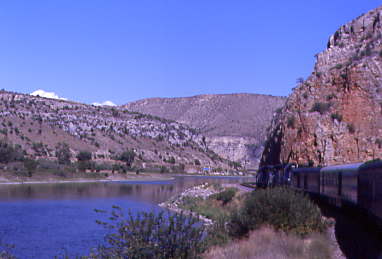
My mother, Nancy, saw an advertisement in the travel section of the Los Angeles Times on Sunday July 27th, 2003 and suggested that we should go to Montana to ride this seasonal excursion train. It was a trip that I had wanted to take for years and the special round trip price of $895 for two definitely beat the one-way price of $599 for one. I checked the air fares to Spokane on the Alaska Airlines website and gave my mother the prices; she called the Montana Rockies Rail Tours and learned the trip would be out of Bozeman. Alaska's partner, Horizon Air, flew into Bozeman so that would not be a problem. My mother then called and booked our trip and I worked on getting us there. The price of the flight was really high so I offered to use my Alaska Airlines miles to get us there, which then cut the fare in half, making it acceptable. I did all this online and received more airline miles doing it that way.
Alaska Airlines Flight 489 8/21/2003Packing first thing in the morning, I drove my mother and I to my brother Jon's house and left my car in his driveway before he drove us to Orange County Airport. Having printed our boarding passes, we joined the security line which was the worst I had ever seen and it took us forty-three minutes then reached Gate 13 at 7:45 AM for our 9:34 AM flight to Seattle. I bought a USA Today as we waited. At 8:55, the gate was changed to Gate 10 which at least had an Alaska plane at it. We boarded at 9:28 and I had window seat 10F on this 737-400 plane then took off at 9:47 AM and after flying over a deck of clouds into Oregon, Mount Hood was beautiful and I finally had an excellent view of Mount St. Helens before we touched down at 11:50 and arrived at Gate D11. Since our next flight was at Gate C2G, I introduced my mother to the Satellite Transit System to get us to the C Terminal. Once there, my mother decided to get some Ivar's clam chowder while I watched the bags. My turn was next and I took the shuttle train to the N gates for two scoops of Dryer's mint chip ice cream then returned to our gate to while listening to the Chicago albums 12 and 13.
Horizon Air Flight 2385 8/21/2003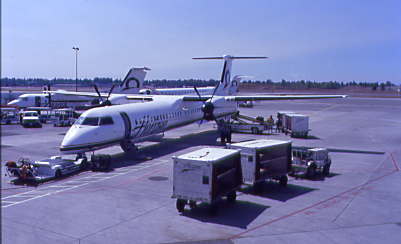
At 2:50 PM, boarding was announced so we walked down some stairs and through a covered passageway to the end exiting onto the tarmac, boarding the Bombardier Q400, a plane with two large propellers. I was in seat 15G and we took off at 3:16 PM, with a flight highlight of the Spirit of Washington Dinner Train in Renton and the former Milwaukee Road crossing of the Cascade Mountains. Horizon served free wine and beer on their flights, which made my mother really happy to be able to enjoyi a glass of wine on our flight. Out of the window, we saw many large wildfires burning out-of-control, spewing large plumes of smoke into the Montana sky. We landed in Butte at 5:34 PM MDT and took off at 5:45 PM for the fifteen-minute flight to Bozeman. The highlight of this flight was seeing the former Milwaukee Road grade, especially the Vendrome Loops, before touching down at 6:19 at the Gallatin Field Airport. We called the hotel and twenty minutes later, a van arrived and we were driven to the Best Western GranTree Inn. Following our tour introduction from Daniel Sullivan, we enjoyed dinner in the hotel's restaurant then I went for a long walk before watching "Without A Trace" and calling it a night.
Montana Rockies Rail Tours' The Montana Daylight 8/22/2003Waking up to alarm clocks and wake-up calls, my mother and I enjoyed a buffet breakfast before boarding the bus for the journey on Interstate 90 to Livingston. We would cross Bozeman Pass east on the highway then later west on our train trip.
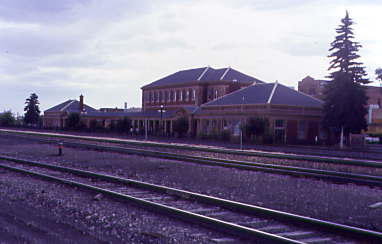
At Livingston, we toured the Livingston Station Museum before I walked over to photograph the exterior of this Northern Pacific station built in 1902. The helpers returned from a train we saw crossing Bozeman Pass and passed us before our train reversed into the depot.

At 8:35 AM, boarding began with Montana Gold and Big Sky, the first class portion. With only two gate entrances to the train, boarding was a very slow process then it was re-spotted for the Discovery passengers. Due to misinformation, we were some of the very last to board and the car we were told to go into had no seats, so we went into the next one, finding a pair of seats at the bulkhead with no fold-down tables. I thought we could do better, so ventured into the next car, former Santa Fe coach 4734 and found a pair of seats with a much better view.
We were seated in Discovery Service, which is coach service with huge picture windows and long-distance reclining seats with fold-down tables. Complimentary snack and non-alcoholic beverages were served by the always-smiling car attendants. Lunches are served at your seat with a beverage. The trip is fully narrated with all points of interest pointed out. We each received a "Corps of Discovery" lapel pin and had access to the lounge car which contained the train's gift shop. Great pictures could be taken from the car's vestibules. All passengers on the train were given a "Notes Along The Way" guide that had important route information and highlights.
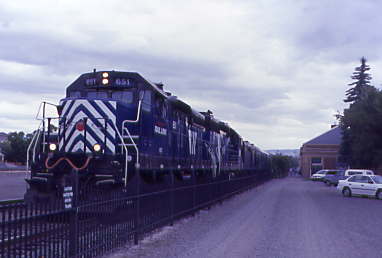
Our train consisted of Montana Rail Link SD19-1 651 and 652, power car 104, crew car 151, former US Army baggage 150, used as a dormitory and commissary car, coaches 4013 (Southern Pacific), 4734 (Santa Fe), 4700 (Santa Fe) and 4001 (Southern Pacific), lounge 3150 (Santa Fe), diner 8750 (Atlanta and West Point), dome coaches Californiza Zephyr 22 (Rio Grande), 9410 (Great Northern) and 9407 (Northern Pacific) and "Bella Vista", a competely rebuilt private car used for Gold Service with a dome, bedrooms, a kitchen and covered open rear platform. It wa a very impressive train.
We departed Livingston at 9:18 AM and started my new mileage over the rails of Montana Rail Link.
A Brief HistoryThe Northern Pacific Railroad Company was created on July 2, 1864 when President Abraham Lincoln signed an act of Congress for the construction of it. It would be built from the Great Lakes to the Puget Sound and would follow the route Lewis and Clark had followed across the west. Ground breaking took place in Carlton, Minnesota in the east and Kalama, Washington in the west, in 1870. Over the next three years, it was built from Duluth to Bismarck, North Dakota in the east and north to Tacoma in the west. The line was in trouble and by the Panic of 1873, Cooke and Company lost control with the line sitting idle for a few years. Henry Villard used a "Blind Pool" to finance the rest of the construction in 1881.
The crews built in earnest in 1882 to complete the railroad by 1883. The line was completed with the pounding of the Golden Spike at Gold Creek, Montana on September 8, 1883 as the first of the northern lines to be built to the Puget Sound in Washington. While the line ended up being the longest of all the lines built to the Pacific Northwest, it did benefit from serving most of the major cities that developed in the states it served, something neither the Great Northern, nor later the Milwaukee Road, could lay claim to.
The North Coast Limited was introduced on April 29, 1900 as the crack passenger train of the railroad and in 1947, it was improved by adding diesel engines and new lightweight equipment. In October 16, 1952, the Mainstreeter was introduced as a second transcontinental passenger train. Vista Domes and Dome Sleepers were added to the North Coast Limited on August 16, 1954 and in 1955, stewardess-nurse service was added, another Pacific Northwest "first". Both the North Coast Limited and the Mainstreeter passed the Northern Pacific's merger into the Burlington Northern on March 3, 1970 and were discontinued with the start-up of Amtrak on May 1, 1971.
Amtrak reinstated a train over the old Northern Pacific route across Montana on June 5, 1971 as the North Coast Hiawatha, which ran until the October 1, 1979 bloodbath that was a result of a hostile Department of Transportation. Montana Rail Link was organized on July 1, 1987 to start operating the former Northern Pacific line between Sandpoint, Idaho and Billings, Montana to operate the freight service over this piece of railroad for the Burlington Northern in a haulage agreement. That then led to the formation, in 1995, of the Montana Rockies Rail Tours by LLC with four partners that started operating seasonal passenger trains. In the year 2000, the company was purchased by Rail Quest America, who now operates the Montana Daylight on an increased schedule.
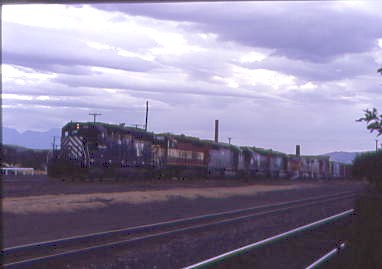
The train that we had passed on the way here had five locomotives cut-off, then three were added to the point of this train, while the other five pushed near the rear.
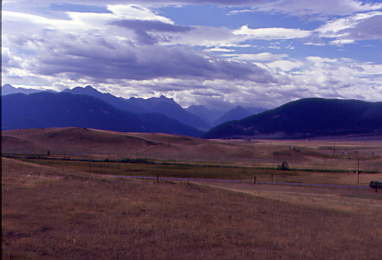
On the move and climbing, looking back toward Livingston.
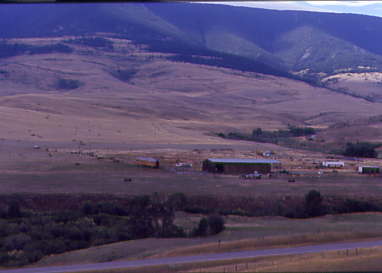
Looking down on the farm with a passenger car.
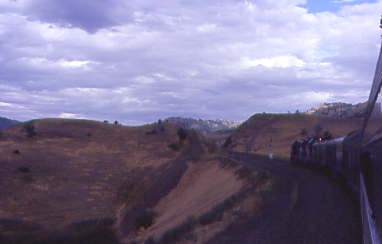
Our train climbing the 2.2 percent grade up Bozeman Pass.
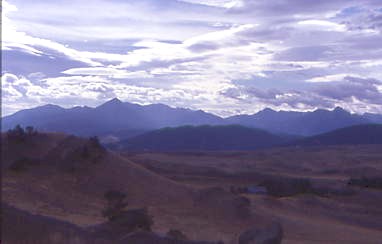
Looking back at the beautiful view.
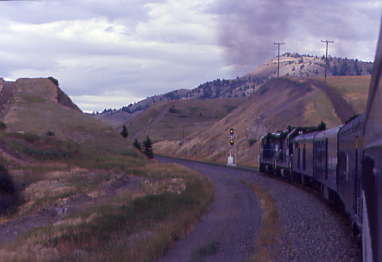
We received a double yellow signal.

We went into the 8,065 foot Muir siding at Milepost 127.1 to run around BBNSF 4338 East.
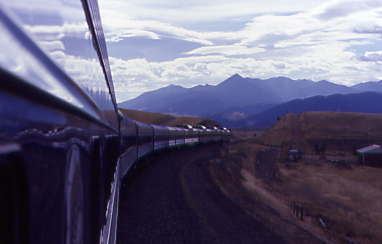
I immediately went to the vestibule for the 2.2 percent grade from Livingston, at 4,746 feet above sea levelm to the 5,760 foot summit of Bozeman Pass, which was the highest point on the original Northern Pacific mainline.
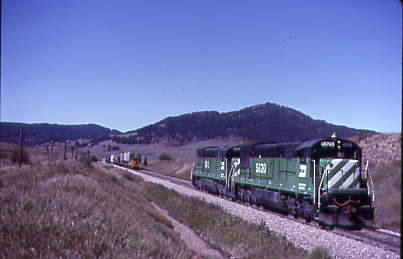
My first visit here was on August 29th, 1985, when, after pushing BN 6827 through Bozeman Tunnel, the helpers cut off at West End without the train stopping.
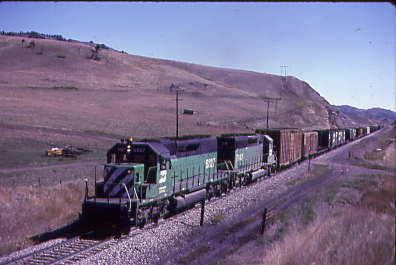
The MRL helper set returning to Livingston, also on August 29th, 1985.
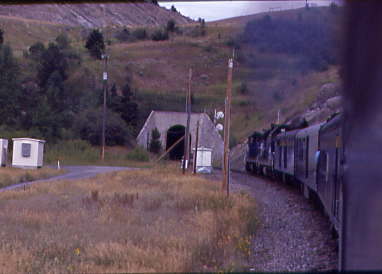
As we started our climb, the Absaroka Range was to the east and the Bridger Mountains, where we were going, were to the west. Looking south, one could see the Paradise Valley that leads to Yellowstone National Park. It was a really windy morning but the views were so stunning. Our two locomotives were working hard, with great chugging sounds and really smoking it up, reminiscent of a steam engine and we climbed the brown slopes with green next to the creeks.
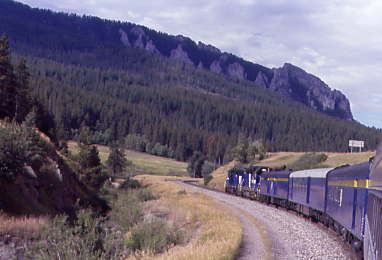
At Milepost 128, we plunged into the Bozeman Tunnel, a 3,015 foot long tunnel completed on July 28th, 1945, replacing the original tunnel built in 1883. The vestibules were closed to keep the diesel smoke out of our train.
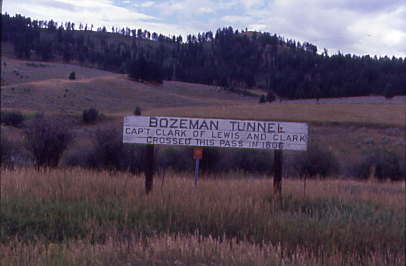
We emerged at West End, passed the original tunnel entrance and then the Bozeman Pass sign.
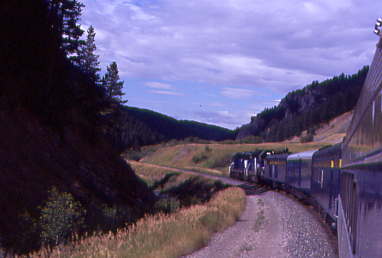
Once through the tunnel, we descended into the beautiful Rocky Canyon, following Rocky Creek.
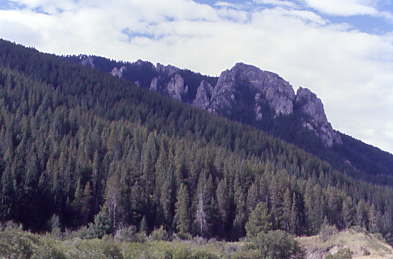
Our train twisted and turned down the grade.
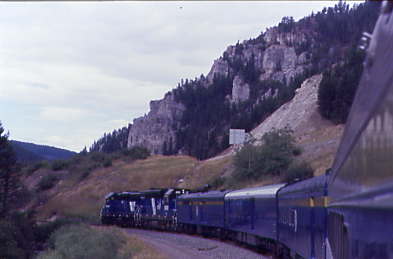
The beautiful rocky peaks to the south.
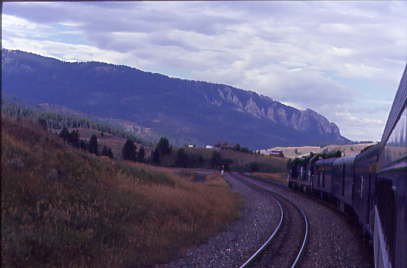
Continuing our journey down Rocky Canyon.
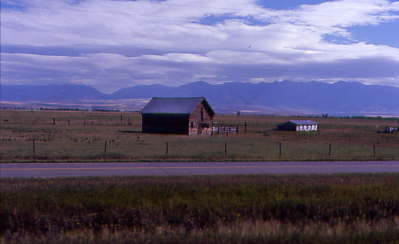
Bozeman at Milepost 140.4 and 4746 feet in elevation.
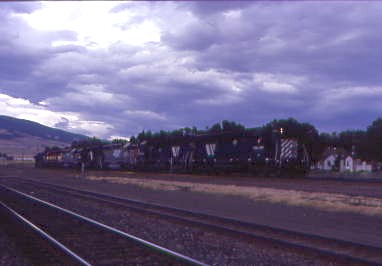
We took the 10,045 foot siding passing a MRL helper set. As we departed, the Bozeman Mountains were to the northeast, while the Madison Mountains with the Spanish Peaks were to the south. We turned to the west to start our journey down the longest tangent track on Montana Rail Link, a distance of 13.3 miles then passed Belgrade at Milepost 149.8, the location of Gallatin Airport, also known as Bozeman International Airport, which we flew into yesterday. We curved right before Manhattan and crossed the Gallatin River at Milepost 155.6 then reached Logan, where the former North Coast Limited route used to run via Butte.
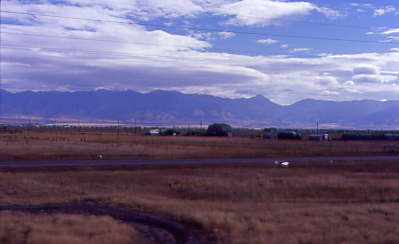
The Bridger Mountains once you enter the Gallatin Valley.

Further along, the low hills to the north of the Gallatin River.
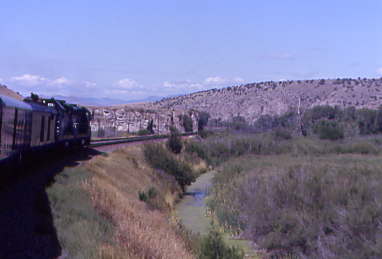
We paralleled the Gallatin River west until Three Forks.
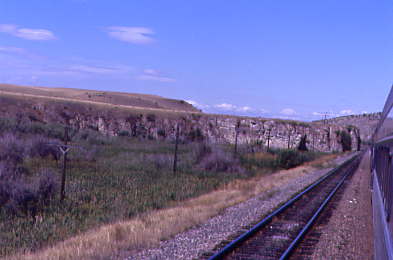
The rock outcroppings on the left.
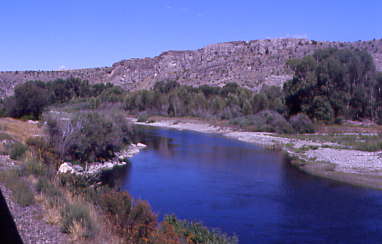
Our train cruising along the Gallatin River.
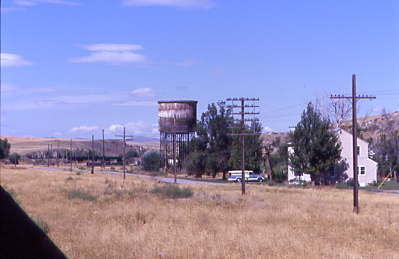
Logan has one of the last remaining Northern Pacific water towers.
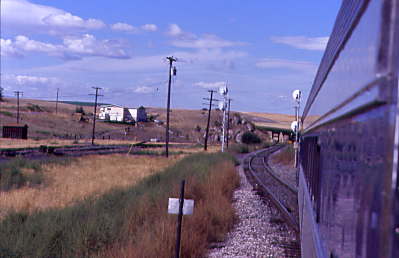
Logan, at Milepost 164.8. We stayed on the route of Northern Pacific's Mainstreeter.
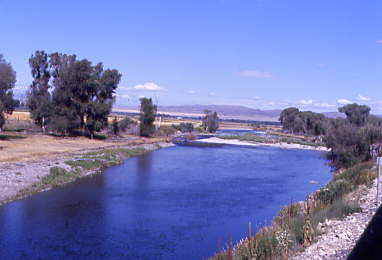
The ever-changing views.
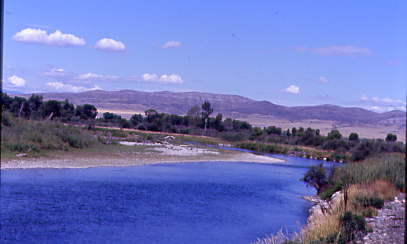
Nearing Three Forks, where the Gallatin River empties into the Missouri River. We passed the headwaters of the Missouri River at Mileost 169 and a minute later, saw where the Gallatin River flows into the Jefferson and Madison Rivers, forming the Missouri River.
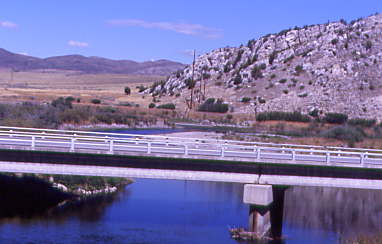
The Lewis and Clark Expedition went through here on their westward journey on July 28th, 1805. From Three Forks to Townsend, we would follow the Missouri River through the canyon.

Across the Missouri River, I spotted the former grade of the Milwaukee Road then a trestle and later an overhead wire pole.
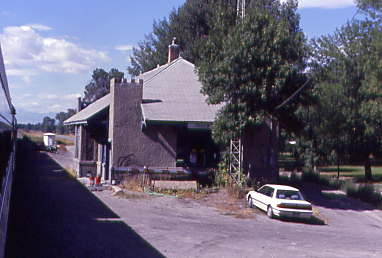
We entered the Missouri River Canyon at Three Forks and first came to the company town of Trident, Milepost 170.5, with the Northern Pacific depot built in 1911. We then lost the roads and entered the beautiful Missouri River Canyon as the tracks were on the east bank while the former Milwaukee Road was on the west bank. The views were constantly changing as we passed Clarkston siding at Milepost 178.9 and the spur track at Stanley, Milepost 183.15.
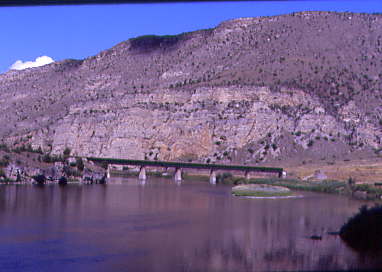
We turned to the west and into view came Lombard, where we crossed Sixteen Mile Creek, which the Milwaukee Road followed out of the Missouri River Canyon, then stopped unexpectedly and my car was right at the Milwaukee Road bridge. The train was inspected and work was done on one of the dome cars. On the move again, the former foundations of the coke ovens of the Western Coal and Coke Company were seen.
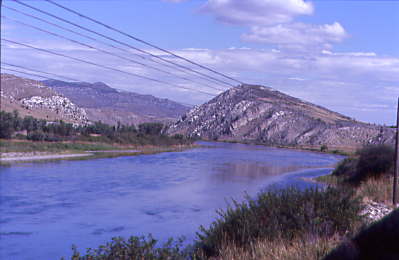
The Canyon had ever-changing views as we followed the Missouri River.

Across the river is the grade of the old Milwaukee Road that we would follow to Lombard where it bridged the Missouri River and a trestle bridge is very visible.
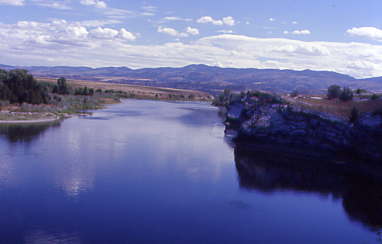
Another Missouri River view looking north.
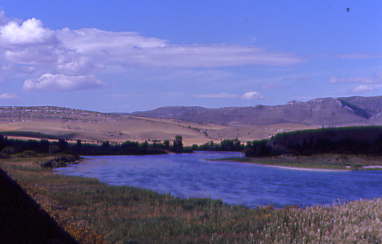
Further on, a view looking south back up the Missouri River.
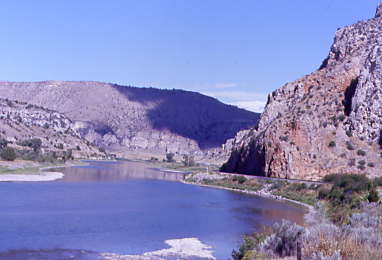
The canyon walls became more colourful as we continued north.
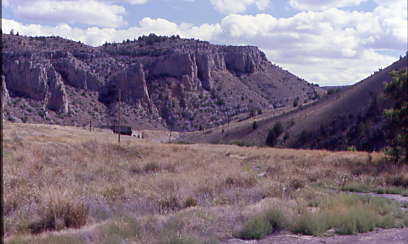
After the Milwaukee Road crossed the Missouri River at Lombard, it climbed Sixteen Mile Canyon towards Harlowton, Montana.
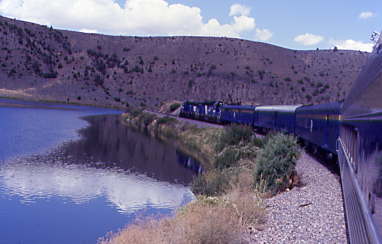
The Montana Daylight cruising the Missouri River Canyon.
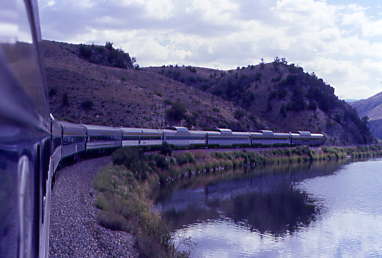
The view to our rear.
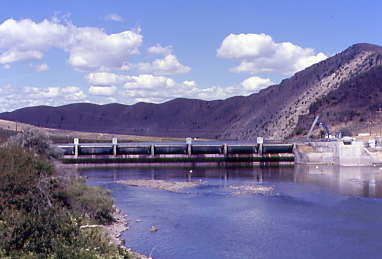
Toston Dam at Milepost 189, is a diversion dam operated by the Bureau of Land Management, built in 1939 to provide irrigation water for the surrounding area.
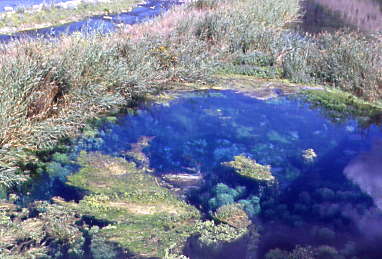
Right next to the tracks, Mammoth Cold Springs with its wonderful colours.
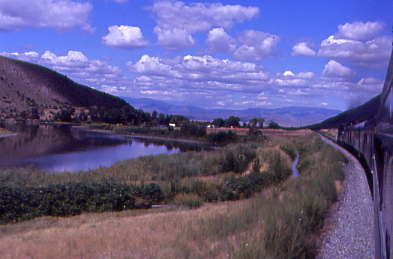
The Montana Daylight exiting the Missouri River Canyon. We reached the eastern end of Toston Reservoir and it was truly a Montana Big Sky day with very pleasant temperatures. At Milepost 190, we crossed Mammoth Springs, a source of the Big Spring Ditch, which is an irrigation project.
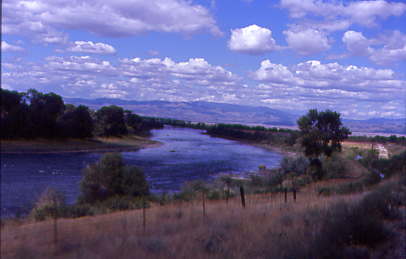
We continued to Toston before exiting the Missouri River Canyon at Townsend. At Milepost 206.3, we crossed the Missouri River before it flowed northwest into Canyon Ferry Lake, which was visible for the next forty minutes. The Big Belt Mountains were to the north, while the Elk Horn Mountains were to the southwest. To leave the Missouri River Valley, our train climbed Winston Hill, crested at 4,351 feet, before our next short climb to Spokane Summit at 4,346 feet, prior to descending into the Helena Valley.
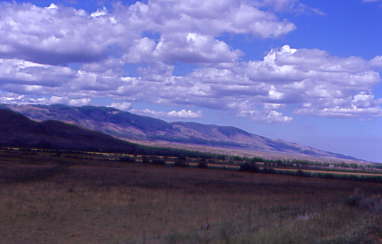
Looking southwest towards the Elkhorn Mountains.

The Canyon Ferry Reservoir dominated the view to the north for the next thirty miles.
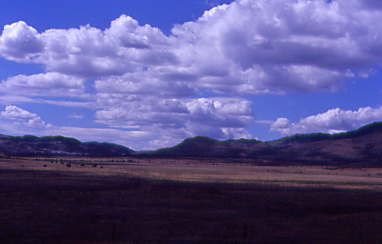
The Montana Daylight climbing Winston Hill.
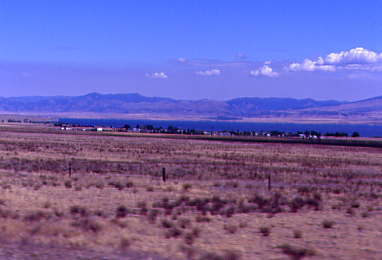
Looking northwest at Canyon Ferry Reservoir.
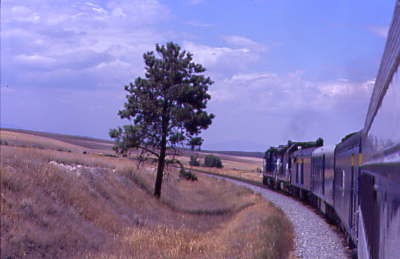
This lone tree made me think of the U2 song "One Lone Tree".
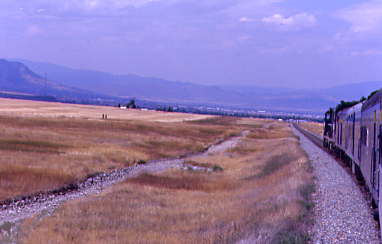
We proceeded to Helena, the State Capital of Montana and passed through Louisville at Milepost 227.4.
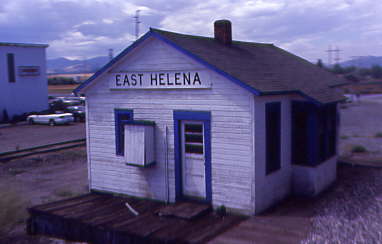
We crossed Prickly Pear Creek then the former Northern Pacific East Helena station, which used to be a telgraph station at Louisville, then made our way into Helena, and the capitol building with its copper dome could be seen. We made an extended stop here to drop off a female worker before the train was blue-flagged and one of the dome cars was being worked on as it lightly rained. An eastbound freight with a Chicago and North Western locomotive arrived before the blue flag was dropped and we were on the move again.
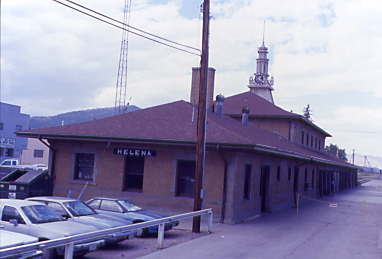
The Northern Pacific Helena depot built in 1904.
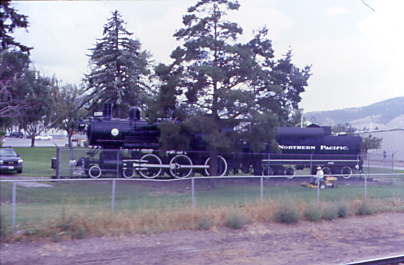
Northern Pacific 4-6-0 1382 built by Burnham, Williams and Company in 1902. It was retired in the mid-1950's and donated to the City of Helena, where it is on display near the Union Depot in Beattie Park. Our train started the assault on Mullan Pass. Helena is located at 3,930 feet and the summit at Blossburg and our crossing of the Continental Divide, is at 5,548 feet, so we would climb the 2.2 percent grade to the summit west of Mullan Tunnel. We passed Helena Junction at Milepost 2.95, where a Great Northern line to Great Falls took off from the Northern Pacific-built mainline. To the south, Harrison Reservation could be seen as we followed Seven Mile Creek.
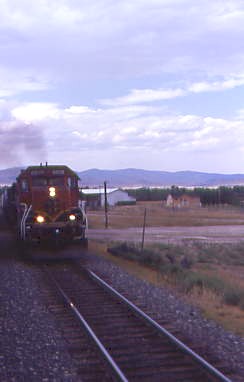
Starting up Mullan Pass, we first met an eastbound freight.

Heading straight for Mullan Pass.
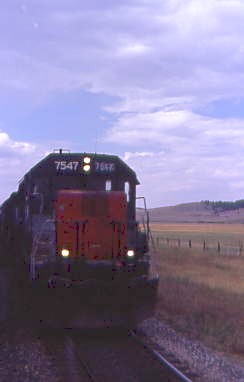
That was followed by a helper set returning to Helena.
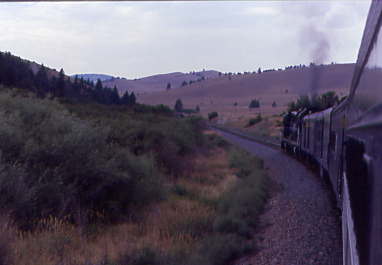
The grade now made our SD19-1s really work. We met two eastbounds on the double track on our way to Tobin at Milepost 5.2, and returned to our single track-running for our climb then passed through Birdseye, where we started to follow Greenhorn Creek.
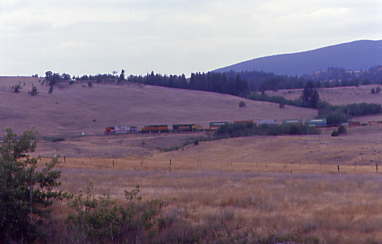
A BNSF stack train coming down the middle level on a red signal due to BNSF 9679 holding the main at Austin Loops ahead of us.
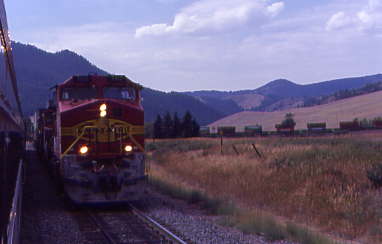
Santa Fe 703 East (BNSF) finally received a yellow to pass.
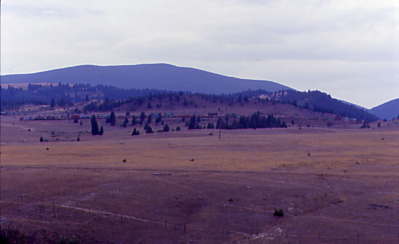
The train reached Austin with a BNSF empty coal train holding the mainline for us to arrive.
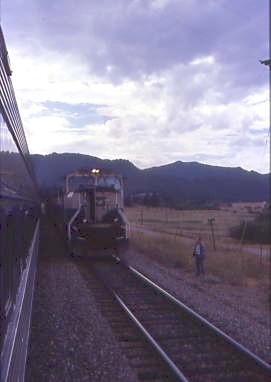
At Austin, Milepost 13, we went into the 6,825 foot siding to let BNSF 9679 East, an empty coal train, go by.
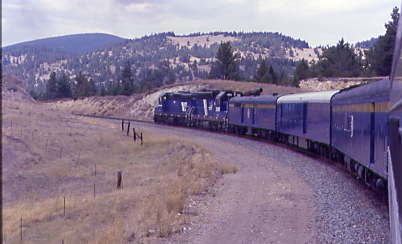
We turned 180 degrees to climb the middle level before we turning the other 180 degrees back to the southwest.

It was our turn to climb the Austin Loops, a series of 10 degree curves used to bypass an original survey that would have required a large and expensive viaduct over Skully Gulch.
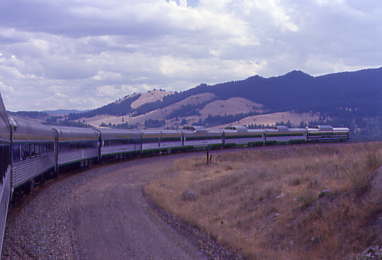
The view was spectacular and it was a treat to ride over. At Weed, Milepost 16, we passed the former Iron Ridge Tunnel which was abandoned in 1965 due to a line change.

Our engines leading us across the 580 foot long, 98 foot high viaduct, Greenhorn Trestle, over Greenhorn Gulch.

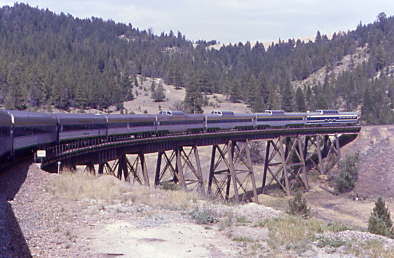
A mile-and-a-half later, we crossed Skyline Trestle which was 494 feet long and 94 feet high over Austin Gulch on a ten degree curve.
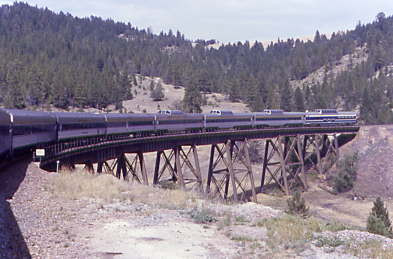
Of course, our dome cars followed right behind.
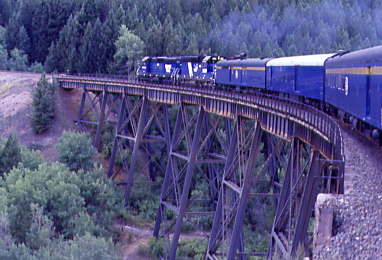
That led us to the east portal of the 3,898 foot long Mullan Tunnel at Milepost 19.6, where all the vestibules were again closed for the tunnel passage.

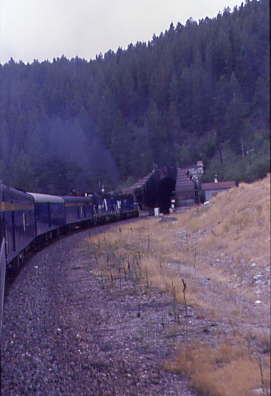
The train exited the west portal at Blossburg; this is where the line to Butte takes off.
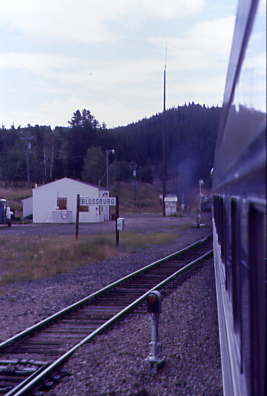
We crossed the Continental Divide at 5,548 feet above sea level.
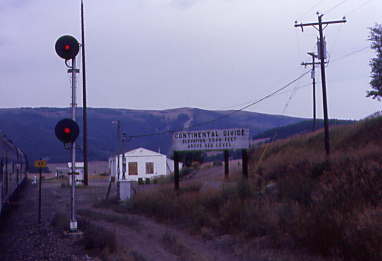
What an incredible climb it was over Mullan Pass and I was so glad to have finally been able to ride over it.
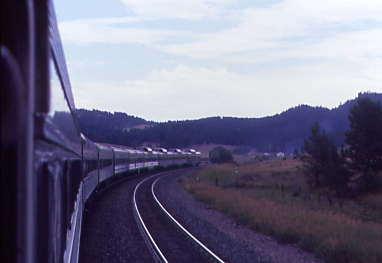
The Montana Daylight left the Continental Divide behind as it drifted downgrade.
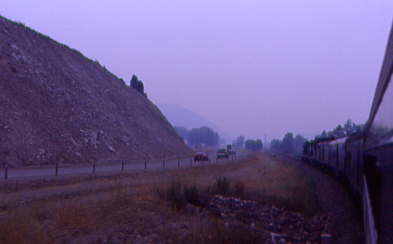
Proceeding into the smoke of some of the 57 wildfires that were burning in the state during our visit.
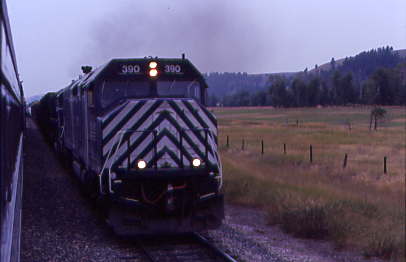
Going down the west slope at a much faster pace, we crossed Dog Creek before reaching the Little Black Foot River at Milepost 22, which we would follow to Garrison. At Elliston, Milepost 28.9, we held the main for an eastbound MRL freight led by F45 390.
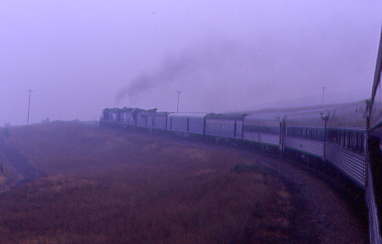
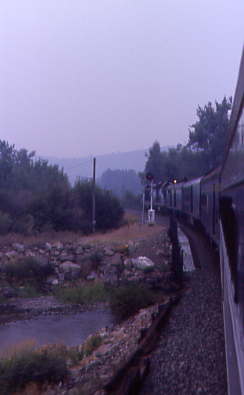
Crossing Little Black Foot River and passing the block signal.
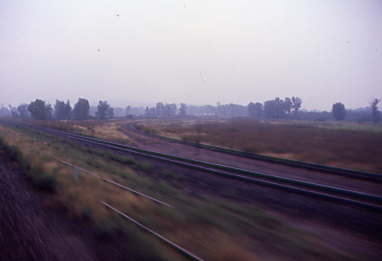
At Garrison, Milepost 50.5, the line through Butte, that the North Coast Limited took which left us at Logan, rejoined our route. It was all smoke as rain started to fall off and on as we continued west to Missoula and I hoped this rain would help the fire fighting efforts. I returned to my coach seat as I did not feel like breathing smoke. Our route was joined by the Clark Fork River, which we could follow to Pend Oreille Lake just to the east of Sandpoint, unless we went over Evaro Hill tomorrow.
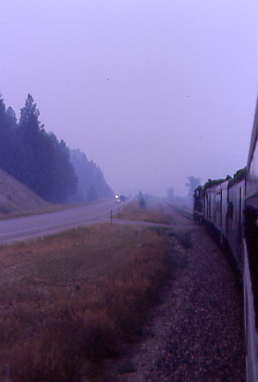
There were a total of eighteen crossings of the Clark Fork River before we could arrive in Idaho. Through the smoke, you could barely see the Flint Creek Mountains to the south and the Garret Mountains to the north. We passed through the 1,394 foot Garrison tunnel prior to passing the Last Spike marker sign at Milepost 54, commemorating where, on August 22nd, 1883, the Northern Pacific was completed.
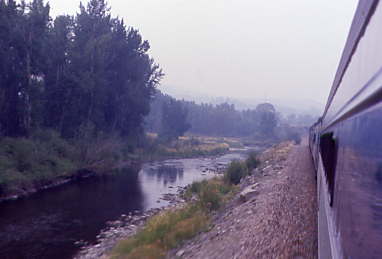
Cruising through the smoke and rain along the Clark Fork Riverc Gold Creek joined the Clark Fork River before we reached Drummond where the Phillipsburg Branch left the mainline. It was operated from 1887 until it was taken out of service in 1983. The former Milwaukee Road line had been paralleling our route since Garrison. At Bearmouth there is the elephant rock formation to the north.
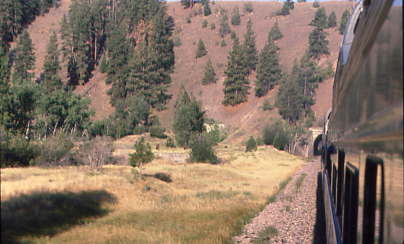
Later we travelled through the 909 foot Nimrod Tunnel at Milepost 90.8 and later, the 896 foot Bonita Tunnel at Milepost 94.4. At the town of Bonner, Milepost 113.68, the Stimson Lumber Company stood out to our north then we crossed the Blackfoot River right below Milltown Dam, built in 1907, on the Clark Fork River. We then crossed Rattlesnake Creek prior to our arrival at Missoula in the rain.

Northern Pacific 4-6-0 1365 built by Burnham, Williams and Company in 1902. It was first assigned to haul the North Coast Limited between Missoula and Spokane but that was short-lived, as 4-6-2s soon took over. It was then reassigned to branchline freight, mixed and passenger service. After completing its last run on 16th June 1954 helping the Mainstreeter over Evaro Mountain, 1365 had run over a million miles in service, working every branch line on the Rocky Mountain Division. Slated for the torch and actually moved to South Tacoma for disposal, the locomotive was rescued by the determined efforts of enthusiasts like the photographer Ron V. Nixon and the interest of Northern Pacific Director Walter H. McLeod amongst others. 1365 was cosmetically restored and moved to Missoula and dedicated at its current site on 10th November 1955.
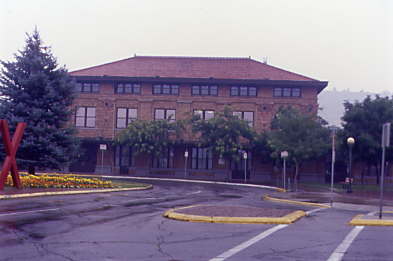
The beautiful Northern Pacific station built in 1901. The railroad constructed Missoula's first depot in 1883. This temporary wooden structure was replaced with a fine new building in 1896, constructed by the Higgins brothers, who intended to turn it over to Northern Pacific officials in exchange for building costs. Just prior to completion, arson reduced the uninsured building to ruins. Several years later, the Northern Pacific built the present depot. The celebrated St. Paul architectural firm of Reed and Stem, which specialized in railroad depot design (and eventually designed over one hundred depots, as well as the engineering specifications for New York City's Grand Central Station) drew the blueprints for this splendid symbol of Missoula’s importance.
The brick depot, designed in simplified Renaissance Revival style, presides over Circle Square at the foot of the commercial district. Terra cotta roof tile, brick pilasters and gently arched windows lend refined dignity. Terra cotta medallions, which enclose the Northern Pacific emblem, recall the original function of this commanding building, when the railroad reigned supreme.
My mother and I detrained to a waiting bus. Standing there, looking at the Montana Daylight train, I could not believe how outstanding the service had beens. The smiling staff members who provided such superior service created the feeling that I could not wait to ride with them again tomorrow. What a great train riding day it had been! Fantastic train, excellent service and unforgettable scenery.
Missoula 8/22/2003The bus took us to Holiday Inn Parkside where after getting into our room, we ate at the Encore Restaurant. After dinner, I walked over to the Missoula Carousel, a community treasure and the first fully hand-carved carousel built in the United States since the Great Depression, which opened on May 27, 1995. After riding, I returned to the room and spent the next hour-and-a-half writing today's rail adventure. While watching the news, I learnt of a flash flood watch for the burn area with periods of heavy rains forecast, so I hoped the firefighters received the needed rain to help extinguish the blazes burning in the state.
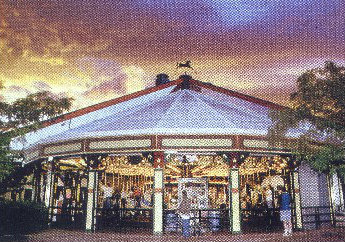
A postcard of the Missoula Carousel.